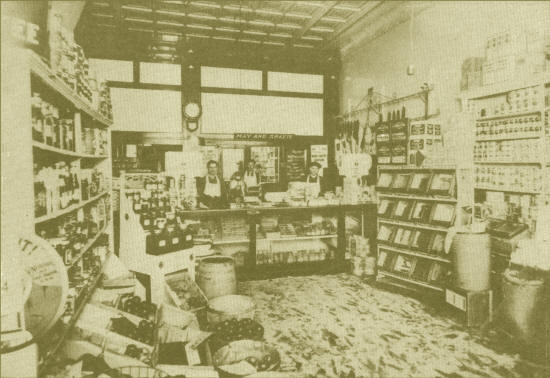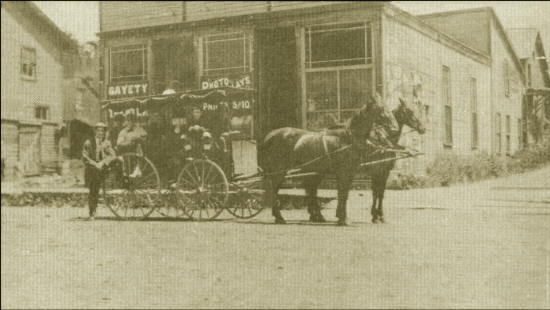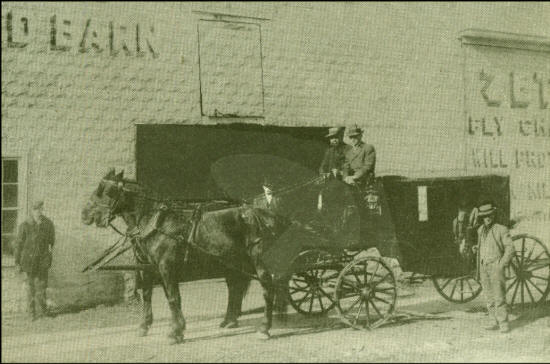|
|
 |
Clark County Press, Neillsville, WI December 21, 1994, Page 20 Transcribed by Dolores (Mohr) Kenyon. Index of "Oldies" Articles
|
|
|
 |
Clark County Press, Neillsville, WI December 21, 1994, Page 20 Transcribed by Dolores (Mohr) Kenyon. Index of "Oldies" Articles
|
Good Old Days
By Dee Zimmerman
Celebrating the Christmas and New Year’s Season always includes eating. There are various traditional foods, many of ethnic backgrounds that have been passed down through the generations. We look forward to partaking of these delicacies when the season arrives.
The Scandinavians are noted for the sandbakelers and rosettes pastries, the lutefisk, and Lefse. The English make delicious plum puddings. Yugoslavian and Polish nationalities have the perogies, made with a variety of fillings. Some of the tastiest desserts to partake of are the Polish coffee cakes, preferably those with a poppy seed filling, my favorite. German favorites are the stolen, sweet breads with citron and dried fruits as flavoring; kuchen, a coffee cake with fruit filling on top. Fruit cakes and Yulakaga are prepared during the holiday season, fruit cakes being baked in early November and marinated with fruit juices, refrigerated and seasoned to be pleasing to the palate on Christmas Eve. Czechoslovakians are sure to prepare kolachies and apple strudel. The list goes on with many family favorites though some are being lost with the “not enough time,” as most are time consuming to mix up, bake, etc. The Christmas cookies are the most popular – everyone finds time to bake and decorate a few dozen of those each year – a must! (Doesn’t this just make you hungry!)
Looking through an old cook book (circa 1900) we found basic recipes that seemed interesting.
Rice Pudding
1 qt. milk
1/3 cup rice
½ tsp. salt
1/s cup sugar
Cinnamon or nutmeg, for flavoring
Wash rice, heat milk and sugar in double boiler, stirring until sugar is dissolved. Add all remaining ingredients and stir three or four times for half an hour. Turn in buttered baking dish and bake in slow oven for three hours. Raisins or dates may be added before baking.
Years ago, mince meat pies were a must. That was when farm families did their own butchering and canned home-made mince meat.
Mince Meat
3 lbs. lean boiled beef
3 qts Chopped apples
2 cups currants
1 cup molasses
1 teas. Nutmeg
1 teas. Powdered mace
1 Tbs salt
2 cups cider
1 ½ lbs suet
1 qt stoned raisins
¼ lb citron
Juice of 2 oranges
Juice of 2 lemons
Grated rind of 1 each
3 cups brown sugar
1 cup sherry
Brandy or sweet pickle vinegar, as desired, may be added.
Chop meat and suet fine, shred the citron. Mix all dry ingredients together, then the liquids (except sherry and brandy). Mix all together well, and bring slowly to boiling point; boil five minutes.
Remove from stove, add sherry and brandy. Mix, then seal in jars. This will make seven quarts.
Custard Pie
2 cups milk
3 eggs
4 Tbs. sugar
1 pinch of salt
Some grated Nutmeg
Break eggs into bowl and beat without separating until light, gradually add sugar, then milk. Pour into pastry lined pie pan, grate some Nutmeg over the top. Bake in moderate oven about 25 minutes. Test in the center with teaspoon handle. It it comes out dry, it is done. If it bakes too long or too fast, it will be watery.
Ginger Snaps
One cup each of sugar, molasses and butter, boiled together; when cool add 1 egg, 1 tsp each of ginger, cinnamon and soda; enough flour to make a soft dough; roll out very thin and bake in a quick oven.
Cream Cookies
Two eggs, 1 cup sour cream, 1 cup butter, 2 cups sugar, 2 level tsp soda. Mix in flour for soft dough.
Chicken Dumplings
1 cup sweet milk, 1 egg well beaten, 1 pint sifted flour, ½ teas salt, 1 Tbsp baking powder. Stir all together well; drop the batter, a spoonful at a time, into chicken broth just checked from boiling. Let boil 15 minutes. These dumplings are very nice.
Johnny Cake
“Two cups corn meal, one cup wheat,
One cup sour milk, one cup sweet,
One cup good eggs that you can eat,
One-half cup molasses, too,
One-half cup sugar and thereto,
Salt and soda, each a spoon,
Mix up quickly and bake it soon.”
When we go to the supermarket shopping for the holiday turkey or ham, finding the right one is usually only a matter of the size of weight, depending on how many people we plan to serve. The turkey is ready to be stuffed, only needs to be rinsed with water and is always a young tender bird – the only kind marketed for roasting. The ham is pre-smoked, of course, boiled, ready-to-eat, with skin and fat trimmed off. That wasn’t the way it was back at the turn of the century…food shopping was much different!
Using your imagination, waling into a meat market, then you would have found the turkeys hanging upside down, on display for the shopper. The 1910 cook book gave the following suggestions:
Select a plump turkey having smooth, dark legs, cartilage at the end of the breast - bone should be rather soft and pliable. Remove the hairs by holding the bird over an alcohol flame or twist a piece of paper up tightly and light it holding turkey over this and changing position often until every part is singed. Cut off the head and with a pointed knife, remove the pin feathers. It is best to have the turkey drawn (entrails removed) by the butcher before you leave the shop.
Preparing ham; Change the water once or twice, soak the ham for 24 hours. Put on to cook in boiling water with a little sage and a cup of vinegar. When very tender, remove the skin and black outside, sprinkle the fat side with sugar and bread crumbs, and brown in the oven.
How to Make Coffee
Do not blame the grocer if your coffee is poor; sometimes the poor coffee is the result of a not perfectly clean coffee pot. Once a week put a teaspoonful of baking soda into the pot; partly fill it with water and boil for at least ten minutes. Then wash thoroughly, and you will find the coffee sweet and clean after that.
Use a white enameled coffee pot for making coffee.
Beat an egg in ¼ cup cold water; add 4 tbs. of coffee grounds (that you have ground as fine as coarse sugar). Pour into the coffee pot and add one cup of boiling water and bring quickly to boiling point. Now this must be done always or the coffee is ruined. Set back on the stove where it will keep hot, but not boiling, and add two cups of boiling water. Let stand two or three minutes, settle the grounds with a very little cold water and serve at once.
My, we certainly don’t go through all of that now for pot of coffee, do we? There are those of us who can remember our mom’s making coffee this way, when using a large one or two gallon enameled coffee pot to make coffee for the threshing crews. The purpose of the egg was to adhere to the coffee ground, settling all at the bottom of the pot with a nice clear coffee as the result. As we recall, it did make good tasting coffee.
All in all, there have been vast changes in the food marketing and food preparation –it has shortened up the homemaker’s work.
•••••••••
Everybody has their tastes in noises as well as in other matters. – Jane Austen
•••••••••
Ideas are a capital that bears interest only in the hands of talent. – Rivarol
•••••••••
He who has imagination but no knowledge has wings but no feet. – Joseph Joubert
•••••••••
A good marriage is that in which each appoints the other guardian of his solitude. – Rainer Maria Rilke
 |
The May and Spaete Meat Market in 1926 was located across from the old Neillsville Bank on Hewett Street. A general line of groceries was marketed as well as a variety of meats. It was the days of fruit, such as apples, being displayed in bushel baskets and boxes. Some foods were distributed in barrels, too. Spaete’s relocated in Granton, later.
 |
An early movie house, of Neillsville, was located on South Hewett Street, on what is now the town square, and was formerly the site of Arbutus Restaurant. It was operated by Tom Hommel and used for itinerant players and movies. Phil Zimmer is in the photo.
 |
Front view of Mead Livery, later the Webster Livery Barn on West 6th Street, Neillsville. It was razed in 1985 and now is a parking lot. (Photos courtesy of the Clark County Historical Society’s Jail Museum)
|
© Every submission is protected by the Digital Millennium Copyright Act of 1998.
Show your appreciation of this freely provided information by not copying it to any other site without our permission.
Become a Clark County History Buff
|
|
A site created and
maintained by the Clark County History Buffs
Webmasters: Leon Konieczny, Tanya Paschke, Janet & Stan Schwarze, James W. Sternitzky,
|